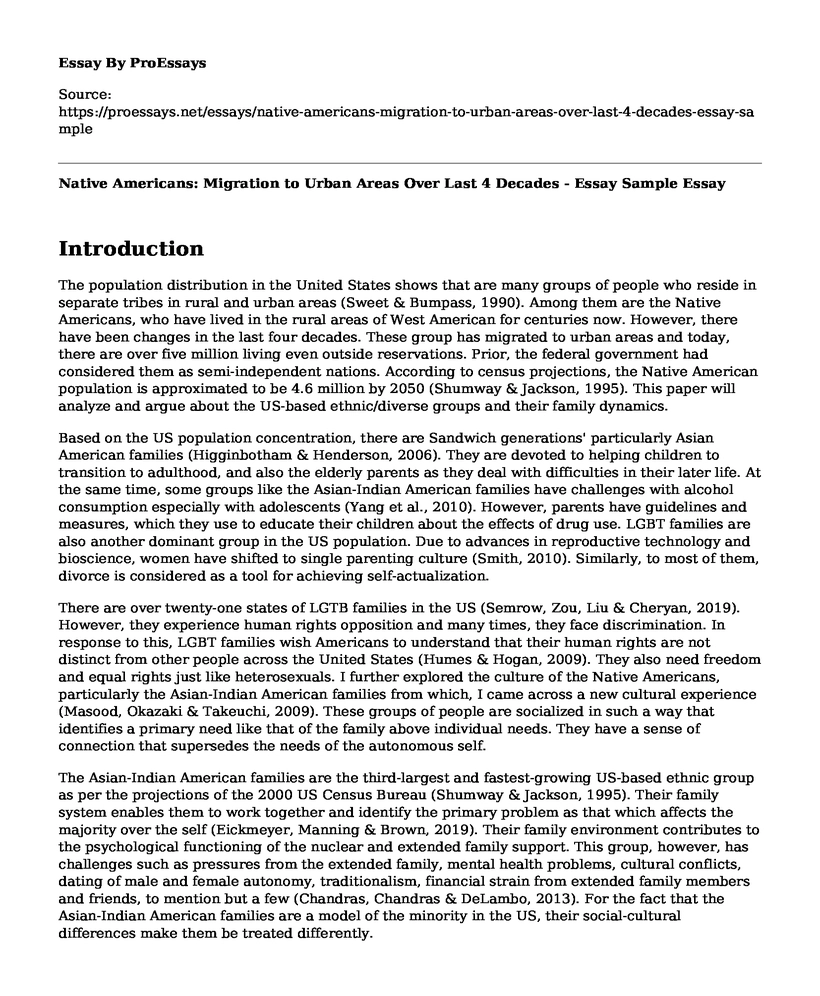Introduction
The population distribution in the United States shows that are many groups of people who reside in separate tribes in rural and urban areas (Sweet & Bumpass, 1990). Among them are the Native Americans, who have lived in the rural areas of West American for centuries now. However, there have been changes in the last four decades. These group has migrated to urban areas and today, there are over five million living even outside reservations. Prior, the federal government had considered them as semi-independent nations. According to census projections, the Native American population is approximated to be 4.6 million by 2050 (Shumway & Jackson, 1995). This paper will analyze and argue about the US-based ethnic/diverse groups and their family dynamics.
Based on the US population concentration, there are Sandwich generations' particularly Asian American families (Higginbotham & Henderson, 2006). They are devoted to helping children to transition to adulthood, and also the elderly parents as they deal with difficulties in their later life. At the same time, some groups like the Asian-Indian American families have challenges with alcohol consumption especially with adolescents (Yang et al., 2010). However, parents have guidelines and measures, which they use to educate their children about the effects of drug use. LGBT families are also another dominant group in the US population. Due to advances in reproductive technology and bioscience, women have shifted to single parenting culture (Smith, 2010). Similarly, to most of them, divorce is considered as a tool for achieving self-actualization.
There are over twenty-one states of LGTB families in the US (Semrow, Zou, Liu & Cheryan, 2019). However, they experience human rights opposition and many times, they face discrimination. In response to this, LGBT families wish Americans to understand that their human rights are not distinct from other people across the United States (Humes & Hogan, 2009). They also need freedom and equal rights just like heterosexuals. I further explored the culture of the Native Americans, particularly the Asian-Indian American families from which, I came across a new cultural experience (Masood, Okazaki & Takeuchi, 2009). These groups of people are socialized in such a way that identifies a primary need like that of the family above individual needs. They have a sense of connection that supersedes the needs of the autonomous self.
The Asian-Indian American families are the third-largest and fastest-growing US-based ethnic group as per the projections of the 2000 US Census Bureau (Shumway & Jackson, 1995). Their family system enables them to work together and identify the primary problem as that which affects the majority over the self (Eickmeyer, Manning & Brown, 2019). Their family environment contributes to the psychological functioning of the nuclear and extended family support. This group, however, has challenges such as pressures from the extended family, mental health problems, cultural conflicts, dating of male and female autonomy, traditionalism, financial strain from extended family members and friends, to mention but a few (Chandras, Chandras & DeLambo, 2013). For the fact that the Asian-Indian American families are a model of the minority in the US, their social-cultural differences make them be treated differently.
Conclusion
In conclusion, demographics in the US are consistently evolving. Social norms are continually changing, new trends are developing, and the number of ethnic groups is growing. Therefore, the federal government should put measures necessary to meet the needs of all groups especially the fastest growing Native Americans. At the same time, there are issues in the LGBT community such as the importance of a father and divorce, which should be addressed to solve problems at the personal and community level.
References
Chandras, K. V., Chandras, S. V., & DeLambo, D. A. (2013). Counseling Asian-American Indians from India: Implications for training multicultural counselors. Ideas and research you can use: VISTAS 2013, https://www.counseling.org/docs/default-source/vistas/counseling-asian-american-indians-from-india---implications-for-training-multicultural-counselors.pdf?sfvrsn=dfac6309_10
Eickmeyer, K. J., Manning, W. D., & Brown, S. L. (2019). What's Mine Is Ours? Income Pooling in American Families. Journal of Marriage and Family, https://www.bgsu.edu/content/dam/BGSU/college-of-arts-and-sciences/center-for-family-and-demographic-research/documents/working-papers/2018/WP-2018-02-Eickmeyer-Whats-Mine-Is-Ours.pdf
Higginbotham, B., & Henderson, K. (2006). Marital Transitions and the Sandwich Generation: The Implications of Divorce and Remarriage, https://digitalcommons.usu.edu/cgi/viewcontent.cgi?referer=&httpsredir=1&article=2529&context=extension_curall
Humes, K., & Hogan, H. (2009). Measurement of race and ethnicity in a changing, multicultural America. Race and Social Problems, 1(3), 111, https://www.researchgate.net/profile/Howard_Hogan/publication/225405395_Measurement_of_Race_and_Ethnicity_in_a_Changing_Multicultural_America/links/5ab40331a6fdcc1bc0c3f5d3/Measurement-of-Race-and-Ethnicity-in-a-Changing-Multicultural-America.pdf
Masood, N., Okazaki, S., & Takeuchi, D. T. (2009). Gender, family, and community correlate of mental health in South Asian Americans. Cultural Diversity and Ethnic Minority Psychology, 15(3), 265, https://www.ncbi.nlm.nih.gov/pmc/articles/PMC3955879/
Semrow, M., Zou, L. X., Liu, S., & Cheryan, S. (2019). Gay Asian Americans Are Seen as More American Than Asian Americans Who Are Presumed Straight. Social Psychological and Personality Science, 1948550619849426, https://www.lindaxzou.com/s/Semrow-et-al-SPPS-2019.pdf
Shumway, J. M., & Jackson, R. H. (1995). Native American population patterns. Geographical Review, 185-201, file:///C:/Users/User/Downloads/GR_1995.pdf
Smith, C. A. (2010). Father matters: why dads are important for their children, https://www.ksre.k-state.edu/historicpublications/pubs/MF2923.pdf
Sweet, J. A., & Bumpass, L. (1990). American families and households. Russell Sage Foundation, https://books.google.com/books?hl=en&lr=&id=ok-6AwAAQBAJ&oi=fnd&pg=PR13&dq=-Asian-Indian+American+families&ots=KER8_8C8Kw&sig=uy_0JA5V89fa0tcQ2vQoWSFUGSk
Yang, N. N., Mazieres, S., Bravi, C., Ray, N., Wang, S., Burley, M. W., ... & Gallo, C. (2010). Contrasting patterns of nuclear and mtDNA diversity in Native American populations. Annals of human genetics, 74(6), 525-538, https://onlinelibrary.wiley.com/doi/pdf/10.1111/j.1469-1809.2010.00608.x
Cite this page
Native Americans: Migration to Urban Areas Over Last 4 Decades - Essay Sample. (2023, Feb 20). Retrieved from https://proessays.net/essays/native-americans-migration-to-urban-areas-over-last-4-decades-essay-sample
If you are the original author of this essay and no longer wish to have it published on the ProEssays website, please click below to request its removal:
- Essay Example on the White-African American Achievement Gap
- Sexism and Social Justice - A Sociology Essay Example
- Influence of Race and Racism on Canadian History - Essay Sample
- Critical Reflection on the Plight of Immigrants in Relation to My Experience as an E.U. Citizen Living in the U.K.
- Essay Example on the Impact of Culture on Communication: Examining Eshaad
- Essay Example on Gender Violence: Legal Solutions and Psychological Effects
- The Essence of Effective Leadership: Key Traits and Characteristics - Essay Sample







